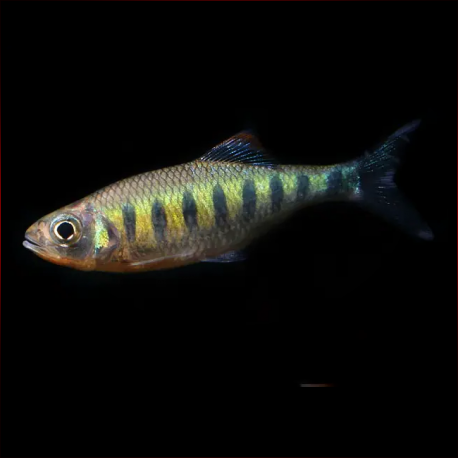More info
Datasheet
| Minimum Tank Size | 540 litres / 142.65 US gallons |
| Maximum Size | 10.5cm / 4.13inches |
| Temperature | 18°C / 64.40°F - 26°C / 78.80°F |
| Hardness | 2.02dgH / 36ppm - 10.03dgH / 179ppm |
| pH | 6.0-7.5 |
General DescriptionBarilius Ardens, a member of the Cyprinidae family under the classification order Cypriniformes, is a species distinguished by a unique color pattern, broad orange margins on its dorsal and anal fins, and specific dental features. Classified as a predominantly surface-feeder, it preys on aquatic and terrestrial insects in its natural habitat, with small fishes and benthic invertebrates also part of its diet.
Aquarium SetupThe optimal tank setup for Barilius Ardens mimics a flowing stream or river, featuring variably-sized rocks, sand, fine gravel, larger boulders, and driftwood. Hardy aquatic plants like Microsorum, Bolbitis, or Anubias spp. can be incorporated. This species requires clean water, high dissolved oxygen levels, and moderate water movement. Regular water changes of 30-50% aquarium volume and a secure cover to prevent jumping are essential.
BehaviourBarilius Ardens is not suitable for community tanks due to its specific environmental needs and fast, vigorous feeding behavior. It tends to outcompete slower species during meals and may prey on much smaller fishes. Maintaining a group of five or more individuals is crucial to prevent bullying among group members and aggression towards similar species.
Feeding and DietIn captivity, Barilius Ardens should be offered a diet of high-quality dried products supplemented with live and frozen foods such as chironomid larvae, Artemia, earthworms, fruit flies, and small gut-loaded crickets. This balanced diet ensures their nutritional requirements are met and supports their overall health.
Reproduction & DimorphismInformation on the reproduction of Barilius Ardens is currently unreported. Sexual dimorphism is observed in adult females, which are less brightly colored, slightly larger, and thicker-bodied than males. During the breeding season, nuptial males develop breeding tubercles on their heads, along with orange pigmentation on their flanks and lower body.
Habitat and DistributionBarilius Ardens is native to the Sita and Swarna river systems in Karnataka state, southwestern India. It inhabits well-oxygenated, fast-flowing rivers and streams with gravel, cobbles, boulders, and exposed bedrock substrates. The species' distribution is primarily limited to specific regions within its natural habitat.

